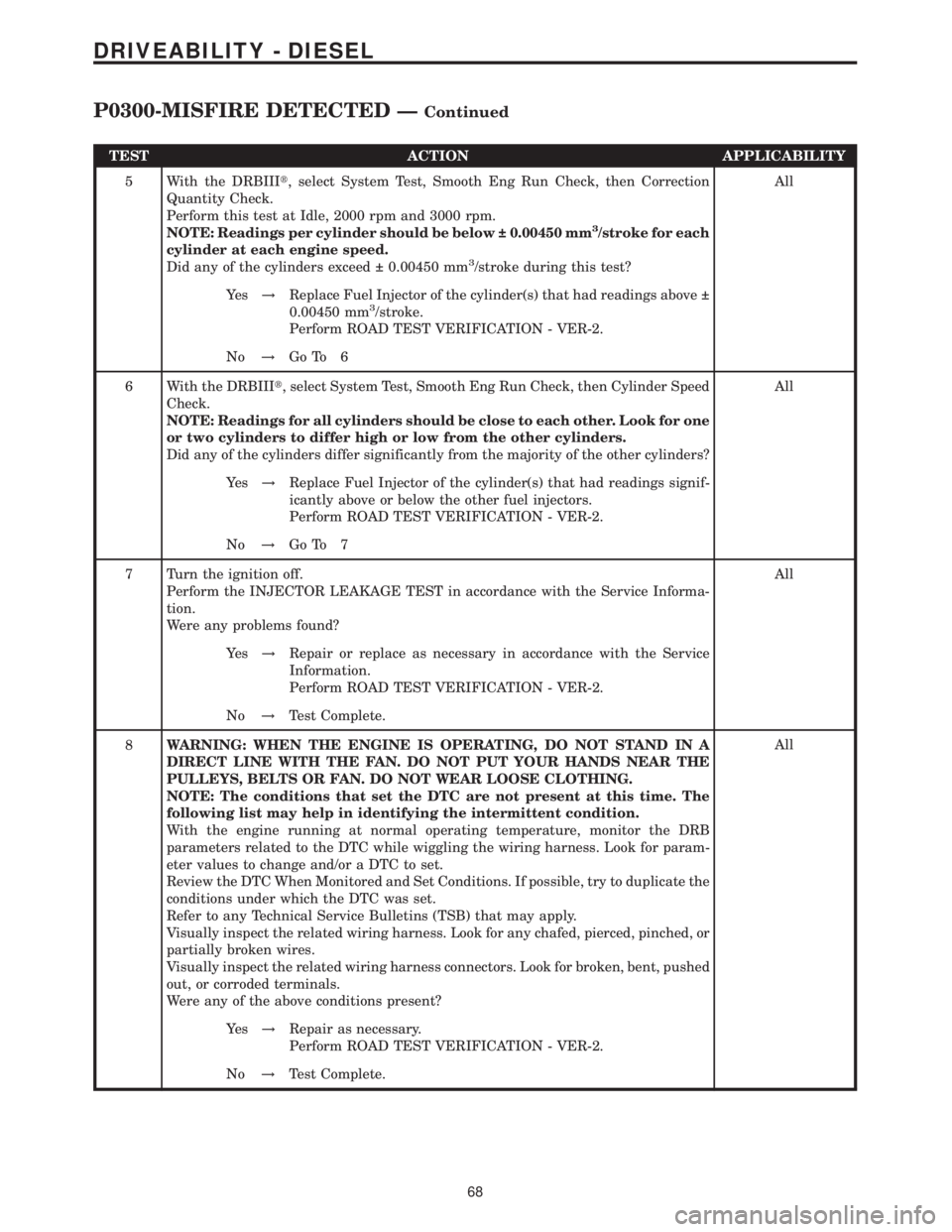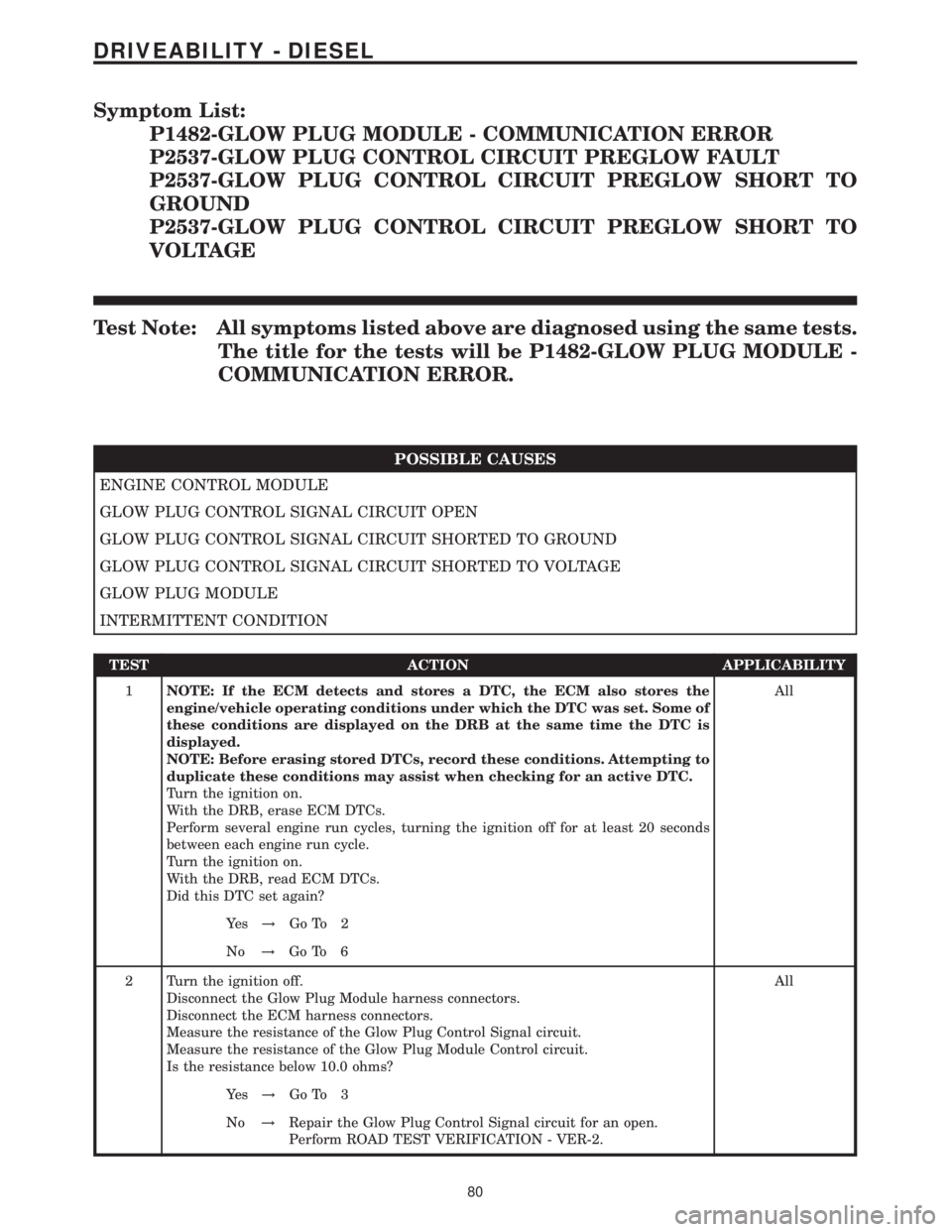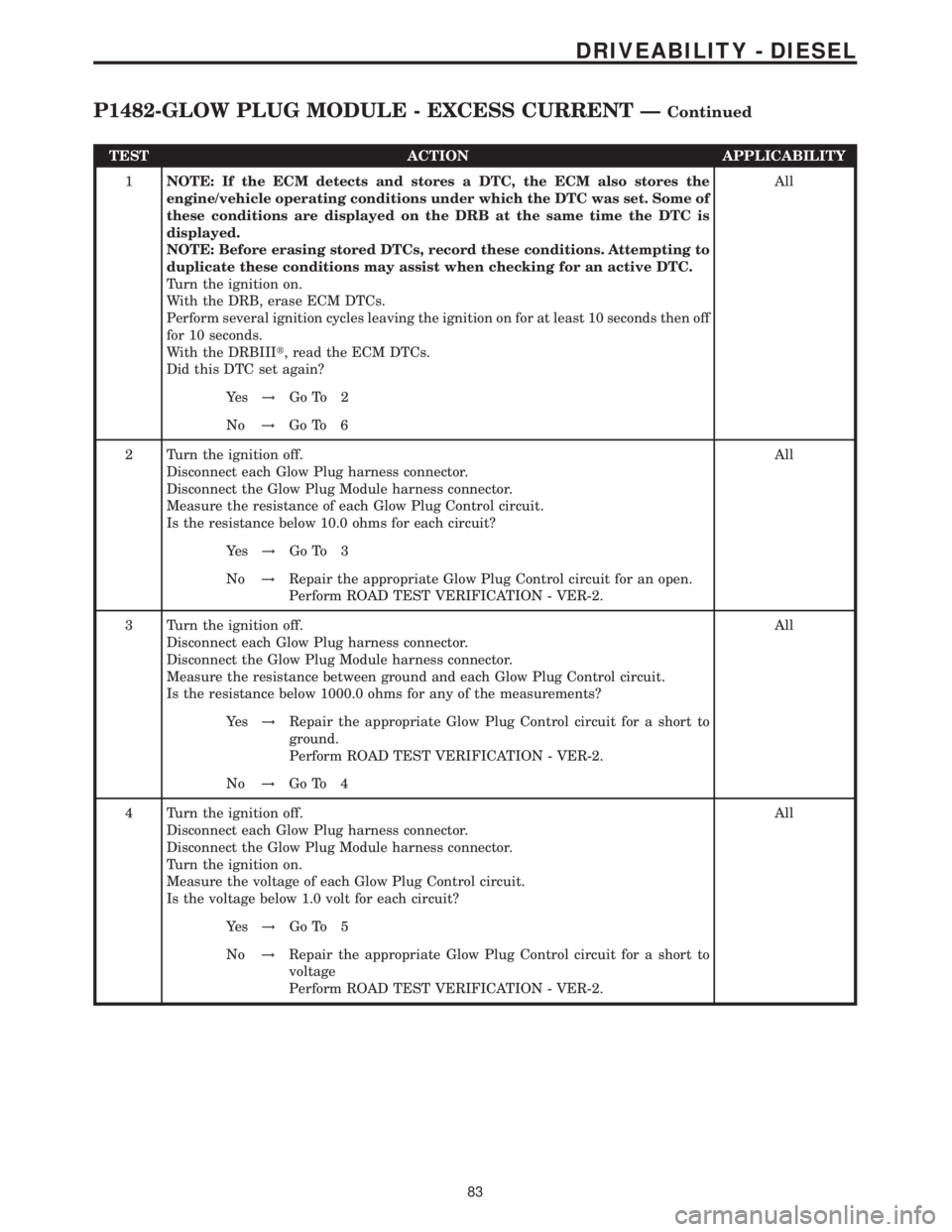2006 MERCEDES-BENZ SPRINTER air condition
[x] Cancel search: air conditionPage 490 of 2305

POSSIBLE CAUSES
CORRECTION QUANTITY CHECK
CYLINDER SPEED CHECK
ENGINE COMPRESSION
INJECTOR LEAKAGE
INTERMITTENT CONDITION
TEST ACTION APPLICABILITY
1NOTE: If the ECM detects and stores a DTC, the ECM also stores the
engine/vehicle operating conditions under which the DTC was set. Some of
these conditions are displayed on the DRB at the same time the DTC is
displayed.
NOTE: Before erasing stored DTCs, record these conditions. Attempting to
duplicate these conditions may assist when checking for an active DTC.
With the DRBIIIt, erase ECM DTCs.
Test drive the vehicle and attempt to duplicate the problem.
With the DRB, read ECM DTC's.
Did this DTC set again?All
Ye s!Go To 2
No!Go To 8
2 Start and idle the engine for 5 minutes.
Turn the ignition off.
Inspect the fuel rail, fuel pressure sensor, fuel pressure solenoid and all fuel injectors
for evidence of fuel leakage.
Is there fuel leakage near any of the injectors or the fuel rail?All
Ye s!Refer to the Service Information to repair fuel leakage.
Perform ROAD TEST VERIFICATION - VER-2.
No!Go To 3
3 Turn the ignition off.
With the DRBIIIt, perform the Cylinder Compression Test.
Is the cylinder compression within specification for all cylinders?All
Ye s!Go To 4
No!Repair as necessary in accordance with the Service Information.
Perform ROAD TEST VERIFICATION - VER-2.
4 Turn the ignition off.
Read and note the six-digit code located on the top of each injector.
Turn the ignition on.
With the DRBIIIt, check the current programmed injector classifications to the
six-digit codes from the vehicles current fuel injectors.
Are all of the Fuel Injectors classified correctly?All
Ye s!Go To 5
No!Using the DRB III, reset injectors to correct classification.
Perform ROAD TEST VERIFICATION - VER-2.
67
DRIVEABILITY - DIESEL
P0300-MISFIRE DETECTED ÐContinued
Page 491 of 2305

TEST ACTION APPLICABILITY
5 With the DRBIIIt, select System Test, Smooth Eng Run Check, then Correction
Quantity Check.
Perform this test at Idle, 2000 rpm and 3000 rpm.
NOTE: Readings per cylinder should be below 0.00450 mm
3/stroke for each
cylinder at each engine speed.
Did any of the cylinders exceed 0.00450 mm
3/stroke during this test?All
Ye s!Replace Fuel Injector of the cylinder(s) that had readings above
0.00450 mm
3/stroke.
Perform ROAD TEST VERIFICATION - VER-2.
No!Go To 6
6 With the DRBIIIt, select System Test, Smooth Eng Run Check, then Cylinder Speed
Check.
NOTE: Readings for all cylinders should be close to each other. Look for one
or two cylinders to differ high or low from the other cylinders.
Did any of the cylinders differ significantly from the majority of the other cylinders?All
Ye s!Replace Fuel Injector of the cylinder(s) that had readings signif-
icantly above or below the other fuel injectors.
Perform ROAD TEST VERIFICATION - VER-2.
No!Go To 7
7 Turn the ignition off.
Perform the INJECTOR LEAKAGE TEST in accordance with the Service Informa-
tion.
Were any problems found?All
Ye s!Repair or replace as necessary in accordance with the Service
Information.
Perform ROAD TEST VERIFICATION - VER-2.
No!Test Complete.
8WARNING: WHEN THE ENGINE IS OPERATING, DO NOT STAND IN A
DIRECT LINE WITH THE FAN. DO NOT PUT YOUR HANDS NEAR THE
PULLEYS, BELTS OR FAN. DO NOT WEAR LOOSE CLOTHING.
NOTE: The conditions that set the DTC are not present at this time. The
following list may help in identifying the intermittent condition.
With the engine running at normal operating temperature, monitor the DRB
parameters related to the DTC while wiggling the wiring harness. Look for param-
eter values to change and/or a DTC to set.
Review the DTC When Monitored and Set Conditions. If possible, try to duplicate the
conditions under which the DTC was set.
Refer to any Technical Service Bulletins (TSB) that may apply.
Visually inspect the related wiring harness. Look for any chafed, pierced, pinched, or
partially broken wires.
Visually inspect the related wiring harness connectors. Look for broken, bent, pushed
out, or corroded terminals.
Were any of the above conditions present?All
Ye s!Repair as necessary.
Perform ROAD TEST VERIFICATION - VER-2.
No!Test Complete.
68
DRIVEABILITY - DIESEL
P0300-MISFIRE DETECTED ÐContinued
Page 493 of 2305

TEST ACTION APPLICABILITY
3NOTE: The TCM Receives vehicle speed messages via CAB Bus from the ABS
module. An interruption on the CAN Bus can cause this fault to set.
Turn the ignition on.
With the DRB, check the TCM for DTCs.
Are any ABS CAN Bus Message or Vehicle Speed related TCM DTCs present?All
Ye s!Replace the CAB in accordance with the Service Information.
Perform ROAD TEST VERIFICATION - VER-2.
No!Replace and program the Engine Control Module in accordance
with the Service Information.
Perform ROAD TEST VERIFICATION - VER-2.
4WARNING: WHEN THE ENGINE IS OPERATING, DO NOT STAND IN A
DIRECT LINE WITH THE FAN. DO NOT PUT YOUR HANDS NEAR THE
PULLEYS, BELTS OR FAN. DO NOT WEAR LOOSE CLOTHING.
NOTE: The conditions that set the DTC are not present at this time. The
following list may help in identifying the intermittent condition.
With the engine running at normal operating temperature, monitor the DRB
parameters related to the DTC while wiggling the wiring harness. Look for param-
eter values to change and/or a DTC to set.
Review the DTC When Monitored and Set Conditions. If possible, try to duplicate the
conditions under which the DTC was set.
Refer to any Technical Service Bulletins (TSB) that may apply.
Visually inspect the related wiring harness. Look for any chafed, pierced, pinched, or
partially broken wires.
Visually inspect the related wiring harness connectors. Look for broken, bent, pushed
out, or corroded terminals.
Were any of the above conditions present?All
Ye s!Repair as necessary.
Perform ROAD TEST VERIFICATION - VER-2.
No!Test Complete.
70
DRIVEABILITY - DIESEL
P0500-WHEEL SPEED SENSOR PLAUS - CAN BUS MESSAGE FROM ABS
Ð
Continued
Page 495 of 2305

TEST ACTION APPLICABILITY
3 Turn the ignition off to the lock position.
Disconnect the TCM C2 harness connector.
Disconnect the ECM harness connector.
NOTE: Check connectors - Clean/repair as necessary.
Measure the resistance of both the CAN C Bus (+) circuit and the CAN C Bus (-)
circuit between the TCM C2 harness connector and ECM harness connector.
Is the resistance below 10.0 ohms for each measurement?All
Ye s!Replace the Engine Control Module in accordance with the
Service Information.
Perform ROAD TEST VERIFICATION - VER-2.
No!Repair the CAN C Bus (+) and/or CAN C Bus (-) circuit for an
open.
Perform BODY VERIFICATION TEST - VER 1.
4WARNING: WHEN THE ENGINE IS OPERATING, DO NOT STAND IN A
DIRECT LINE WITH THE FAN. DO NOT PUT YOUR HANDS NEAR THE
PULLEYS, BELTS OR FAN. DO NOT WEAR LOOSE CLOTHING.
NOTE: The conditions that set the DTC are not present at this time. The
following list may help in identifying the intermittent condition.
With the engine running at normal operating temperature, monitor the DRB
parameters related to the DTC while wiggling the wiring harness. Look for param-
eter values to change and/or a DTC to set.
Review the DTC When Monitored and Set Conditions. If possible, try to duplicate the
conditions under which the DTC was set.
Refer to any Technical Service Bulletins (TSB) that may apply.
Visually inspect the related wiring harness. Look for any chafed, pierced, pinched, or
partially broken wires.
Visually inspect the related wiring harness connectors. Look for broken, bent, pushed
out, or corroded terminals.
Were any of the above conditions present?All
Ye s!Repair as necessary.
Perform BODY VERIFICATION TEST - VER 1.
No!Test Complete.
72
DRIVEABILITY - DIESEL
P0600-CAN DATA BUS - BUS CIRCUIT FAULT ÐContinued
Page 498 of 2305

TEST ACTION APPLICABILITY
4WARNING: WHEN THE ENGINE IS OPERATING, DO NOT STAND IN A
DIRECT LINE WITH THE FAN. DO NOT PUT YOUR HANDS NEAR THE
PULLEYS, BELTS OR FAN. DO NOT WEAR LOOSE CLOTHING.
NOTE: The conditions that set the DTC are not present at this time. The
following list may help in identifying the intermittent condition.
With the engine running and at normal operating temperature, monitor the DRB
parameters related to the DTC while wiggling the wiring harness. Look for param-
eter values to change and/or a DTC to set.
Review the DTC When Monitored and Set Conditions. If possible, try to duplicate the
conditions under which the DTC was set by slowly pressing and releasing the
accelerator pedal several times.
Refer to any Technical Service Bulletins (TSB) that may apply.
Visually inspect the related wiring harness. Look for any chafed, pierced, pinched, or
partially broken wires.
Visually inspect the related wiring harness connectors. Look for broken, bent, pushed
out, or corroded terminals.
Were any of the above conditions present?All
Ye s!Repair as necessary.
Perform ROAD TEST VERIFICATION - VER-2.
No!Test Complete.
5NOTE: Perform the rest of this diagnostic procedure on the individual APP
Sensor Potentiometer (1 or 2) that did not display the correct voltages in the
previous test.
Turn the ignition off.
Disconnect the APP Sensor harness connector.
Turn the ignition on.
Measure the voltage of the 5-Volt Supply circuit in the APP Sensor harness connector.
Is the voltage between 4.7 and 5.3 volts?All
Ye s!Go To 6
No!Go To 14
6 Turn the ignition off.
Disconnect the APP Sensor harness connector.
Connect a jumper wire between APP Sensor Signal circuit and the 5-volt supply
circuit at the APP Sensor harness connector .
With the DRB, read the PEDAL OUTPUT VOLTS.
Does the DRB display between 4.0 and 5.5 volts?All
Ye s!Go To 7
No!Go To 10
7 Turn the ignition off.
Disconnect the APP Sensor harness connector.
Disconnect the ECM harness connectors.
Remove the Engine Control Relay.
Connect a jumper wire between cavity 30 and cavity 87 of the Engine Control Relay
connector.
Turn the ignition on.
Measure the voltage of the APP Sensor Ground circuit.
Is the voltage above 1.0 volt?All
Ye s!Repair the App Sensor Ground circuit for a short to voltage.
Perform ROAD TEST VERIFICATION - VER-2.
No!Go To 8
75
DRIVEABILITY - DIESEL
P1222-ACC PEDAL POSITION SENSOR 1 CKT PLAUSIBILITY ÐContinued
Page 503 of 2305

Symptom List:
P1482-GLOW PLUG MODULE - COMMUNICATION ERROR
P2537-GLOW PLUG CONTROL CIRCUIT PREGLOW FAULT
P2537-GLOW PLUG CONTROL CIRCUIT PREGLOW SHORT TO
GROUND
P2537-GLOW PLUG CONTROL CIRCUIT PREGLOW SHORT TO
VOLTAGE
Test Note: All symptoms listed above are diagnosed using the same tests.
The title for the tests will be P1482-GLOW PLUG MODULE -
COMMUNICATION ERROR.
POSSIBLE CAUSES
ENGINE CONTROL MODULE
GLOW PLUG CONTROL SIGNAL CIRCUIT OPEN
GLOW PLUG CONTROL SIGNAL CIRCUIT SHORTED TO GROUND
GLOW PLUG CONTROL SIGNAL CIRCUIT SHORTED TO VOLTAGE
GLOW PLUG MODULE
INTERMITTENT CONDITION
TEST ACTION APPLICABILITY
1NOTE: If the ECM detects and stores a DTC, the ECM also stores the
engine/vehicle operating conditions under which the DTC was set. Some of
these conditions are displayed on the DRB at the same time the DTC is
displayed.
NOTE: Before erasing stored DTCs, record these conditions. Attempting to
duplicate these conditions may assist when checking for an active DTC.
Turn the ignition on.
With the DRB, erase ECM DTCs.
Perform several engine run cycles, turning the ignition off for at least 20 seconds
between each engine run cycle.
Turn the ignition on.
With the DRB, read ECM DTCs.
Did this DTC set again?All
Ye s!Go To 2
No!Go To 6
2 Turn the ignition off.
Disconnect the Glow Plug Module harness connectors.
Disconnect the ECM harness connectors.
Measure the resistance of the Glow Plug Control Signal circuit.
Measure the resistance of the Glow Plug Module Control circuit.
Is the resistance below 10.0 ohms?All
Ye s!Go To 3
No!Repair the Glow Plug Control Signal circuit for an open.
Perform ROAD TEST VERIFICATION - VER-2.
80
DRIVEABILITY - DIESEL
Page 504 of 2305

TEST ACTION APPLICABILITY
3 Turn the ignition off.
Disconnect the Glow Plug Module harness connectors.
Disconnect the ECM harness connectors.
Measure the resistance between ground and the Glow Plug Control Signal circuit.
Is the resistance above 1000 ohms?All
Ye s!Go To 4
No!Repair the Glow Plug Control Signal circuit for a short to ground.
Perform ROAD TEST VERIFICATION - VER-2.
4 Turn the ignition off.
Disconnect the Glow Plug Module harness connectors.
Disconnect the ECM harness connectors.
Remove the Engine Control Relay.
Connect a jumper wire between cavity 30 and cavity 87 of the Engine Control Relay
connector.
Measure the voltage of the Glow Plug Control Signal circuit.
Is the voltage below 1.0 volt?All
Ye s!Go To 5
No!Repair the Glow Plug Control Signal circuit for a short to voltage.
Perform ROAD TEST VERIFICATION - VER-2.
5 Turn the ignition off.
Replace the Glow Plug Module in accordance with the Service Information.
Turn the ignition on.
With the DRBIIIt, erase ECM DTCs.
Perform several engine run cycles, turning the ignition off for at least 20 seconds
between each engine run cycle.
With the DRBIIIt, read the ECM DTCs.
Did this DTC set again?All
Ye s!Replace and program the Engine Control Module in accordance
with the Service Information.
Perform ROAD TEST VERIFICATION - VER-2.
No!Test Complete.
6WARNING: WHEN THE ENGINE IS OPERATING, DO NOT STAND IN A
DIRECT LINE WITH THE FAN. DO NOT PUT YOUR HANDS NEAR THE
PULLEYS, BELTS OR FAN. DO NOT WEAR LOOSE CLOTHING.
NOTE: The conditions that set the DTC are not present at this time. The
following list may help in identifying the intermittent condition.
With the engine running at normal operating temperature, monitor the DRB
parameters related to the DTC while wiggling the wiring harness. Look for param-
eter values to change and/or a DTC to set.
Review the DTC When Monitored and Set Conditions. If possible, try to duplicate the
conditions under which the DTC was set.
Refer to any Technical Service Bulletins (TSB) that may apply.
Visually inspect the related wiring harness. Look for any chafed, pierced, pinched, or
partially broken wires.
Visually inspect the related wiring harness connectors. Look for broken, bent, pushed
out, or corroded terminals.
Were any of the above conditions present?All
Ye s!Repair as necessary.
Perform ROAD TEST VERIFICATION - VER-2.
No!Test Complete.
81
DRIVEABILITY - DIESEL
P1482-GLOW PLUG MODULE - COMMUNICATION ERROR ÐContinued
Page 506 of 2305

TEST ACTION APPLICABILITY
1NOTE: If the ECM detects and stores a DTC, the ECM also stores the
engine/vehicle operating conditions under which the DTC was set. Some of
these conditions are displayed on the DRB at the same time the DTC is
displayed.
NOTE: Before erasing stored DTCs, record these conditions. Attempting to
duplicate these conditions may assist when checking for an active DTC.
Turn the ignition on.
With the DRB, erase ECM DTCs.
Perform several ignition cycles leaving the ignition on for at least 10 seconds then off
for 10 seconds.
With the DRBIIIt, read the ECM DTCs.
Did this DTC set again?All
Ye s!Go To 2
No!Go To 6
2 Turn the ignition off.
Disconnect each Glow Plug harness connector.
Disconnect the Glow Plug Module harness connector.
Measure the resistance of each Glow Plug Control circuit.
Is the resistance below 10.0 ohms for each circuit?All
Ye s!Go To 3
No!Repair the appropriate Glow Plug Control circuit for an open.
Perform ROAD TEST VERIFICATION - VER-2.
3 Turn the ignition off.
Disconnect each Glow Plug harness connector.
Disconnect the Glow Plug Module harness connector.
Measure the resistance between ground and each Glow Plug Control circuit.
Is the resistance below 1000.0 ohms for any of the measurements?All
Ye s!Repair the appropriate Glow Plug Control circuit for a short to
ground.
Perform ROAD TEST VERIFICATION - VER-2.
No!Go To 4
4 Turn the ignition off.
Disconnect each Glow Plug harness connector.
Disconnect the Glow Plug Module harness connector.
Turn the ignition on.
Measure the voltage of each Glow Plug Control circuit.
Is the voltage below 1.0 volt for each circuit?All
Ye s!Go To 5
No!Repair the appropriate Glow Plug Control circuit for a short to
voltage
Perform ROAD TEST VERIFICATION - VER-2.
83
DRIVEABILITY - DIESEL
P1482-GLOW PLUG MODULE - EXCESS CURRENT ÐContinued